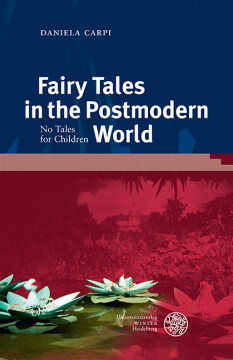
BUCH
Fairy Tales in the Postmodern World
No Tales for Children
Anglistische Forschungen, Bd. 455
2016
Zusätzliche Informationen
Bibliografische Daten
Abstract
In what ways do we look at the fairy tale and its tradition today? Originally an oral narrative based on formulaic repetitions, the fairy tale allows the contemporary writer to be at play with tradition, through a recovering of the canons and formulas of the classical tales that is experimental and ever changing. Fairy-tale readers make personal use of it, resorting for manipulations and rewritings that serve their own specific needs. The expansion of the fairy tale shows ist endless literary evolution thanks to the monumentalisation of the written word, hence the necessity for the literary fairy tale to die, in order to be reborn as literary play. By absorbing ist oral antecedents, the rewriting of the tale of wonder establishes itself as a renovated narrative that continually proves effective in the reconstitution and reaffirmation of human consciousness.
Inhaltsverzeichnis
| Zwischenüberschrift | Seite | Aktion | Preis |
|---|---|---|---|
| Cover | C | ||
| Title Page | 3 | ||
| Copyright | 4 | ||
| Table of contents | 5 | ||
| Chapter 1: Introduction: Re-Reading the Fairy Tale from a Postmodern Perspective | 7 | ||
| Chapter 2: Angela Carter: On the Ruins of Tradition? No Tales for Children | 19 | ||
| Chapter 3: Antonia Byatt’s Metaphorical Perspective | 43 | ||
| Chapter 4: Politically and Legally Correct Fairy Tales | 57 | ||
| Chapter 5: "White as Snow" by Tanith Lee: Between Fable, Gothic Tale, and Myth | 69 | ||
| Chapter 6: "Beauty" by Sheri Tepper | 89 | ||
| Chapter 7: "The Forgotten Garden" by Kate Morton: the novel as fairy tale | 111 | ||
| Chapter 8: "Harry Potter": The Fairy Tale and the Law | 135 | ||
| Chapter 9: Fairy Tales in the Media | 161 | ||
| Chapter 10: Conclusions and exclusions | 173 | ||
| Bibliography | 181 | ||
| Back cover | Back C |


 Publishing Platform by CloudPublish
Publishing Platform by CloudPublish